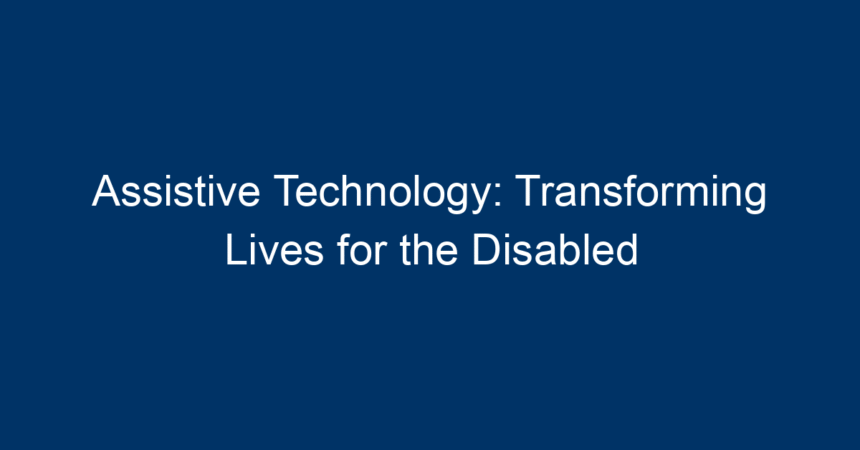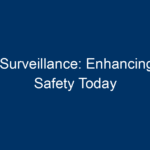In a world that often prioritizes convenience and speed, assistive technology emerges as a powerful equalizer, offering life-changing solutions for individuals with disabilities. Assistive technology encompasses products, services, and systems that help people perform daily activities, enhancing their independence and improving their overall quality of life. Whether it’s through mobility aids, communication devices, or sensory tools, assistive technology is revolutionizing how people with disabilities navigate their environments.
Understanding Assistive Technology
What is Assistive Technology?
Assistive technology (AT) includes a wide range of devices and services that support individuals with disabilities. This can range from simple tools like a magnifying glass to complex software systems that aid communication. The main objective is to enable users to accomplish tasks that could otherwise be challenging or impossible.
Categories of Assistive Technology
Assistive technology can be classified into several categories:
- Mobility Aids: Wheelchairs, walkers, and scooters that help individuals navigate their environments.
- Communication Devices: Augmentative and alternative communication (AAC) devices that assist those with speech or language impairments.
- Hearing Aids: Devices that amplify sound for those with hearing loss.
- Vision Aids: Tools like screen readers, Braille displays, and specialized glasses for individuals with visual impairments.
- Cognitive Aids: Tools that assist with memory, organization, and task management for those with cognitive disabilities.
Each category of assistive technology addresses specific needs and vastly improves the daily experiences of users.
The Impact of Assistive Technology on Everyday Life
Enhancing Independence
For individuals with disabilities, independence is not just a goal; it’s a fundamental right. Assistive technology empowers individuals by providing them with the tools they need to perform daily tasks independently. For example:
- Adaptive Devices: Kitchen tools designed for limited dexterity enable users to cook, manage their homes, and enjoy meal preparation with less assistance.
- Smart Home Technology: Voice-activated systems allow for controlling lights, appliances, and security systems, making daily life more manageable.
Social Inclusion
Social connectivity is crucial for emotional well-being. Assistive technology plays a key role in facilitating communication and social interactions. Communication devices allow individuals with speech impairments to express themselves effectively, building bridges in social settings. Additionally, social media platforms have become invaluable tools for connecting individuals with disabilities, helping them share experiences and form communities.
Educational Advancements
In educational settings, assistive technology helps level the playing field for students with disabilities. Tools such as:
- Text-to-Speech Software: Assisting students with reading difficulties by converting written text into spoken words.
- Interactive Learning Tools: Engaging students with learning disabilities through gamification and personalized feedback.
These technologies not only enhance learning experiences but also foster an inclusive environment where all students can thrive.
The Latest Innovations in Assistive Technology
Wearable Devices
Recent advancements in technology have led to the development of wearable devices that monitor health and mobility. These devices can provide real-time feedback, alerting users to changes in their physical condition and suggesting preventative measures.
Virtual Reality (VR)
VR is being explored as a therapeutic tool for individuals with disabilities. By creating immersive experiences, VR can help users practice real-world skills in a controlled environment, ultimately leading to improved confidence and independence.
Artificial Intelligence (AI)
AI is reshaping assistive technology through predictive analytics and personalized user experiences. AI can adapt tools based on user behavior, making devices more intuitive and effective. For instance, AI-powered communication devices can learn a user’s preferences, streamlining the process of interaction.
Overcoming Challenges in Assistive Technology Adoption
While assistive technology offers unparalleled benefits, there are challenges to its widespread adoption:
Accessibility and Affordability
High costs can be a barrier for many individuals and families. While many insurance plans now cover certain assistive devices, others remain prohibitively expensive. Government and nonprofit organizations play crucial roles in providing funding and resources to help make technology more accessible.
Awareness and Training
A significant barrier to effective adoption is the lack of awareness and understanding about available assistive technologies. Educational institutions, workplaces, and communities must invest in training programs to familiarize people with these technologies, emphasizing their benefits and potential uses.
The Future of Assistive Technology
The future of assistive technology looks promising with increasing investments and innovations. The focus on user-centered design ensures that technology is not only functional but also intuitive and user-friendly.
Collaboration and Feedback
User feedback is essential in shaping the development of new technologies. Collaborations among engineers, designers, users, and healthcare professionals can lead to innovations that truly meet the needs of individuals with disabilities.
Policy Advocacy
Advocating for inclusive policies that support research, development, and funding for assistive technology is crucial. Collaboration among nonprofit organizations, government entities, and the technology sector can drive systematic change and foster innovation.
Actionable Insights for Individuals and Organizations
-
Research Available Technologies: Familiarize yourself with the various types of assistive technology that might suit your needs or those of your loved ones. Websites and organizations dedicated to disability resources can provide valuable information.
-
Advocate for Inclusion: Whether in educational institutions or workplaces, advocate for inclusive practices that support the integration of assistive technology. Highlight the benefits of inclusivity for everyone.
-
Participate in Training: For educators or employers, participating in or organizing training workshops can facilitate a better understanding of assistive technology, promoting a more supportive environment.
-
Leverage Community Resources: Explore local organizations or online communities that focus on the use of assistive technology. These resources can provide tips, support, and potentially funding opportunities for acquiring necessary devices.
- Stay Informed About Innovations: The field of assistive technology is continually evolving. By staying updated on the latest technologies and best practices, individuals and organizations can ensure they are making informed decisions.
Conclusion
Assistive technology is more than just a concept; it represents hope, independence, and empowerment for millions of individuals with disabilities. As innovations continue to emerge, it’s essential to recognize and embrace the transformative potential of these technologies. By understanding, advocating for, and utilizing assistive technology, we can collectively work towards a more inclusive and accessible world for everyone. Embracing assistive technology is not just about enabling tasks—it’s about transforming lives and fostering a society where all individuals can thrive.




